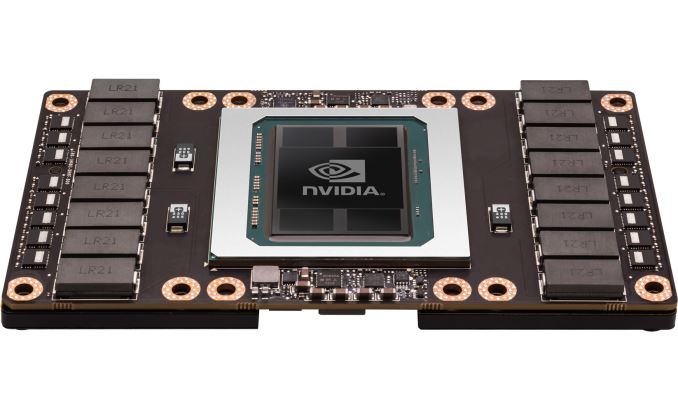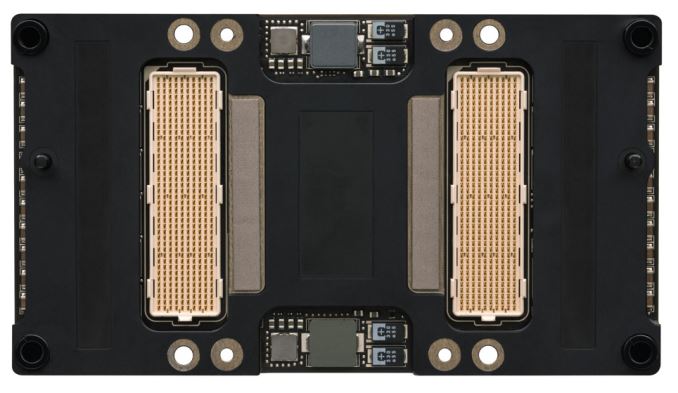NVIDIA Announces Tesla P100 Accelerator - Pascal GP100 Power for HPC
by Ryan Smith on April 5, 2016 3:15 PM EST
Today at their 2016 GPU Technology Conference, NVIDIA announced the first of their Pascal architecture powered Tesla cards, the Tesla P100. The P100 is the first major update to the Tesla HPC family since the launch of the first Kepler cards in late 2012, and represents a very sizable performance increase for the Tesla family thanks to the combination of the smaller 16nm manufacturing process and the Pascal architecture.
| NVIDIA Tesla Family Specification Comparison | ||||||
| Tesla P100 | Tesla K80 | Tesla K40 | Tesla M40 | |||
| Stream Processors | 3584 | 2 x 2496 | 2880 | 3072 | ||
| Core Clock | 1328MHz | 562MHz | 745MHz | 948MHz | ||
| Boost Clock(s) | 1480MHz | 875MHz | 810MHz, 875MHz | 1114MHz | ||
| Memory Clock | 1.4Gbps HBM2 | 5Gbps GDDR5 | 6Gbps GDDR5 | 6Gbps GDDR5 | ||
| Memory Bus Width | 4096-bit | 2 x 384-bit | 384-bit | 384-bit | ||
| Memory Bandwidth | 720GB/sec | 2 x 240GB/sec | 288GB/sec | 288GB/sec | ||
| VRAM | 16GB | 2 x 12GB | 12GB | 12GB | ||
| Half Precision | 21.2 TFLOPS | 8.74 TFLOPS | 4.29 TFLOPS | 6.8 TFLOPS | ||
| Single Precision | 10.6 TFLOPS | 8.74 TFLOPS | 4.29 TFLOPS | 6.8 TFLOPS | ||
| Double Precision | 5.3 TFLOPS (1/2 rate) |
2.91 TFLOPS (1/3 rate) |
1.43 TFLOPS (1/3 rate) |
213 GFLOPS (1/32 rate) |
||
| GPU | GP100 (610mm2) |
GK210 | GK110B | GM200 | ||
| Transistor Count | 15.3B | 2 x 7.1B(?) | 7.1B | 8B | ||
| TDP | 300W | 300W | 235W | 250W | ||
| Cooling | N/A | Passive | Active/Passive | Passive | ||
| Manufacturing Process | TSMC 16nm FinFET | TSMC 28nm | TSMC 28nm | TSMC 28nm | ||
| Architecture | Pascal | Kepler | Kepler | Maxwell 2 | ||
Powering the Tesla P100 is a partially disabled version of NVIDIA's new GP100 GPU, with 56 of 60 SMs enabled. GP100 is a whale of a GPU, measuring 610mm2 in die size on TSMC's 16nm FinFET process and composed of 15.3B transistors. It is remarkable in and of itself that NVIDIA and TSMC are in volume production of such a large 16nm die at this time, as everything else we've seen with a confirmed size is at best one-quarter of this size. GP100 is being produced on TSMC's Chip-On-Wafer-On-Substrate technology, with this line apparently being used for putting the GPU and HBM2 DRAM stacks on the same interposer.
We'll dive into the full Pascal architecture (as implemented by GP100) at a later time, but it's worth noting that Pascal here is 64 FP32 CUDA cores per SM, versus 128 on Maxwell. Each of those SMs also contains 32 FP64 CUDA cores - giving us the 1/2 rate for FP64 - and new to the Pascal architecture is the ability to pack 2 FP16 operations inside a single FP32 CUDA core under the right circumstances. With a boost clock of 1.48GHz, altogether Tesla P100 will offer 10.6 TFLOPS of FP32 performance or 5.3 TFLOPS of FP64 performance, more than doubling and tripling Tesla K40's rated throughput on these metrics respectively. NVIDIA has been happy to crow about the performance of Tesla P100, and for good reason, as this stands to be a very powerful processor.
Paired with the GP100 GPU on Tesla P100 is 16GB of HBM2 VRAM, laid out in 4 stacks for a 4096-bit memory bus. NVIDIA quotes P100 as offering 720GB/sec of memory bandwidth, which works out to a memory clock of 1.4Gbps. As we've seen with other HBM products, this marks a significant increase in memory bandwidth, more than doubling NVIDIA's last generation of cards.
In their announcement, NVIDIA also confirmed that Tesla P100 will support NVLink, with 4 NVLink controllers. Previously announced, NVLink will allow GPUs to connect to either each other or to supporting CPUs (OpenPOWER), offering a higher bandwidth cache coherent link than what PCIe 3 offers. This link will be important for NVIDIA for a number of reasons, as their scalability and unified memory plans are built around its functionality.
Speaking of functionality, Tesla P100 and the underlying GP100 GPU is a full-featured HPC GPU. It supports all of the HPC-centric functionality that the Tesla K20/40/80 embodied, including ECC memory protection for the register file, caches, and HBM2 DRAM. Coupled with the very high FP64 rate, and it's clear that this is the successor of the GK110/GK210 GPU.
NVIDIA's pictures also confirm that this is using their new mezzanine connector, with flat boards no longer on perpendicular cards. This is a very HPC-centric design (I'd expect to see plenty of PCIe cards in time as well), but again was previously announced and is well suited for the market NVIDIA is going after, where these cards will be installed in a manner very similar to LGA CPUs. The P100 is rated for a TDP of 300W, so the cooling requirements are a bit higher than last-generation cards, most of which were in the 230W-250W range.
Finally, in its initial implementation NVIDIA is focusing on customers that need extreme scaling capabilities, and I wouldn't be too surprised if this was in part due to the margins of that market and how these initial cards will be in demand. NVLink of course plays a big part here, with NVIDIA able to go up to 8-way configurations thanks to it.
Source: NVIDIA

















93 Comments
View All Comments
dragonsqrrl - Wednesday, April 6, 2016 - link
If that's the case it would be unprecedented. Nvidia hasn't done that before, and I always thought the reason for that was financial viability. It simply made more sense to invest in a single big die to serve multiple markets. Perhaps the 1/2 ratio might make it impractical as the halo gaming GPU.dragonsqrrl - Tuesday, April 5, 2016 - link
I wouldn't be surprised if it's as little as 1/32 if the current trend continues.extide - Tuesday, April 5, 2016 - link
Probably not, they would just not utilize the nvlink parts on the consumer version of GP100. Note that these still connect to the CPU via PCIe, at least on Xeon systems.HighTech4US - Tuesday, April 5, 2016 - link
NVlink will be used for SLI so yes NVlink will be on consumer Pascals.T1beriu - Wednesday, April 6, 2016 - link
Are you sure? This is the first time I hear this. NVLink used for SLI seems overkill. Isn't NVLink physically extremely complex and thus PCIe can't be used, thus new proprietary slots, thus new motherboards, thus industry goes mad?extide - Thursday, April 7, 2016 - link
Those new 'flat' cards are ONLY going to be used in HPC servers, and even those still connect to the CPU via PCIe. Consumer video cards will be in the normal PCIe expansion card format like they always have been.NVLink will not be used for SLI, it is 100+ pins just for ONE of the four lanes. The existing SLI connector is like 10 pins. NV will just use over-the-pcie like AMD did with Hawaii/XDMA.
dragonsqrrl - Tuesday, April 5, 2016 - link
Same die, binned for different purposes. Wouldn't be unusual for consumer cards to have most FP64 cores fused off during manufacturing.plopke - Tuesday, April 5, 2016 - link
Aren't they doing what you just said , the enteir presentation was about compute/AI/Machine learning/... . So far they have been able to use the same design for their gaming lineup. But these tesla design seams to branch away from conusmers cards.extide - Tuesday, April 5, 2016 - link
Uhh, that is EXACTLY what they are doing...ImSpartacus - Tuesday, April 5, 2016 - link
That's literally the plan.1) AMD's Polaris has no high end chip (Polaris 11 is Pitcairn-level and Polaris 10 is Hawaii-level). Their high end HBM2-packing chips come with Vega in early 2017.
2) GP100 is an absolutely massive chip on an immature process. I doubt we'll see a fully enabled GP100 until at least mid-2017 (probably late 2017 to early 2018).